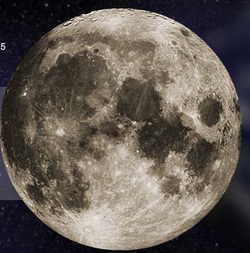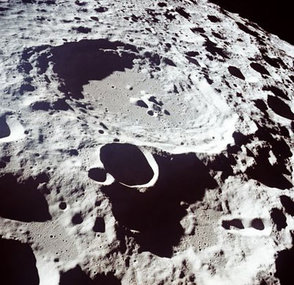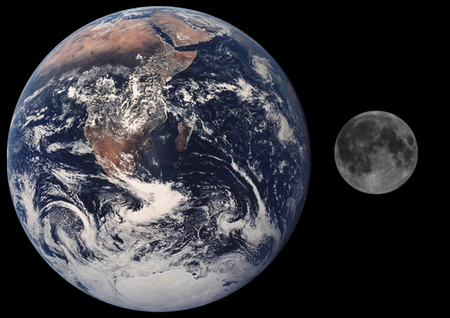Our Solar System
Our natural Satellite (Moon)

Earth has onl one natural satellite, and it is the fifth largest in the solar system. It is about 238,855 miles (384,400 Kilometers) from Earth and makes a complete orbit of the planet in 27 days, 7 hours.
The moon stabilizes Earth's wobble, keeping our climate steady over billion of years. Rocks brought back from the Moon date to the beginning of our solar system (4.5 billion years ago). We have sent more than 70 spacecraft to the moon, and 12 astronauts have walked on its surface.
There are only two basic types of regions on the Moon's surface, there are many interesting surface features such as craters, mountain ranges, rilles, and lava plains. The structure of the Moon's interior is more difficult to study. The Moon's top layer is a rocky solid, perhaps 800 km thick. Beneath this layer is a partially molten zone. Although it is not known for certain, many lunar geologists believe the Moon may have a small iron core, even though the Moon has no magnetic field. By studying the Moon's surface and interior, geologists can learn about the Moon's geological history and its formation.
The footprints left by Apollo astronauts will last for centuries because there is no wind on the Moon. The Moon does not possess any atmosphere, so there is no weather as we are used to on Earth. Because there is no atmosphere to trap heat, the temperatures on the Moon are extreme, ranging from 100° C at noon to -173° C at night.
The Moon doesn't produce its own light, but looks bright because it reflects light from the Sun. Think of the Sun as a light bulb, and the Moon as a mirror, reflecting light from the light bulb. The lunar phase changes as the Moon orbits the Earth and different portions of its surface are illuminated by the Sun.
The moon stabilizes Earth's wobble, keeping our climate steady over billion of years. Rocks brought back from the Moon date to the beginning of our solar system (4.5 billion years ago). We have sent more than 70 spacecraft to the moon, and 12 astronauts have walked on its surface.
There are only two basic types of regions on the Moon's surface, there are many interesting surface features such as craters, mountain ranges, rilles, and lava plains. The structure of the Moon's interior is more difficult to study. The Moon's top layer is a rocky solid, perhaps 800 km thick. Beneath this layer is a partially molten zone. Although it is not known for certain, many lunar geologists believe the Moon may have a small iron core, even though the Moon has no magnetic field. By studying the Moon's surface and interior, geologists can learn about the Moon's geological history and its formation.
The footprints left by Apollo astronauts will last for centuries because there is no wind on the Moon. The Moon does not possess any atmosphere, so there is no weather as we are used to on Earth. Because there is no atmosphere to trap heat, the temperatures on the Moon are extreme, ranging from 100° C at noon to -173° C at night.
The Moon doesn't produce its own light, but looks bright because it reflects light from the Sun. Think of the Sun as a light bulb, and the Moon as a mirror, reflecting light from the light bulb. The lunar phase changes as the Moon orbits the Earth and different portions of its surface are illuminated by the Sun.
Moon's Surface

Much of the Moon's surface is covered with craters. The crater covered regions are at higher altitudes, so they are called the lunar highlands. Lunar craters range in size from over 100 miles in diameter to microscopic size. The craters are universally circular. Some have a small hill in the center.
On Earth craters form either from meteorite impacts or from volcanic eruptions. Lunar craters more closely resemble impact than volcanic craters. Hence astronomers and lunar geologists think lunar craters are impact craters. They formed when meteorites struck the lunar surface with enough energy to explode and form a circular crater.
Most of the craters formed about 4 billion years ago when the lunar surface had recently solidified and the solar system still contained plenty of debris crashing into the Moon. Craters can continue to form, but at a much slower rate because there is less debris to strike the lunar surface. Hence cratered surfaces in the solar system, including the Moon's, are geologically older than uncratered surfaces. That does not mean the moon or planet formed at an earlier time; rather that the surface has had less geological or tectonic activity to obliterate the craters.
Many lunar craters have rays, which are radial spoke-like patterns centered on the crater. When the impact formed the crater, it blasted different colored rocks from beneath the surface outward to form the ray pattern. Rays are one piece of evidence that lunar craters are impact rather than volcanic craters.
On Earth craters form either from meteorite impacts or from volcanic eruptions. Lunar craters more closely resemble impact than volcanic craters. Hence astronomers and lunar geologists think lunar craters are impact craters. They formed when meteorites struck the lunar surface with enough energy to explode and form a circular crater.
Most of the craters formed about 4 billion years ago when the lunar surface had recently solidified and the solar system still contained plenty of debris crashing into the Moon. Craters can continue to form, but at a much slower rate because there is less debris to strike the lunar surface. Hence cratered surfaces in the solar system, including the Moon's, are geologically older than uncratered surfaces. That does not mean the moon or planet formed at an earlier time; rather that the surface has had less geological or tectonic activity to obliterate the craters.
Many lunar craters have rays, which are radial spoke-like patterns centered on the crater. When the impact formed the crater, it blasted different colored rocks from beneath the surface outward to form the ray pattern. Rays are one piece of evidence that lunar craters are impact rather than volcanic craters.
Size Comparision of Earth & Moon

The surface area of the Moon is 37.9 million square kilometers. ( How big is that? Just for comparison, the surface area of Asia is 44.4 million kilometers. If you could unwrap the Moon, it wouldn’t quite fit inside Asia.)
Earth is 510 million square kilometers. 29.2% of the Earth’s surface is covered by land (149 million km2), and 70.8% of the Earth’s surface is water (361 million km2).
